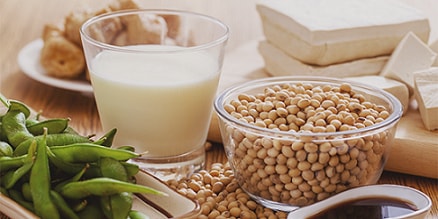The truth about soy: is it good for you?
With soy consumption on the rise, we look at whether it’s actually healthy.
Lucy E Cousins
November 2017
Although the soybean has been a staple food in Asia for thousands of years, it wasn’t until the 1970s that Australian production really took off.
Since then, soy’s popularity here has steadily risen. According to a 2016 Roy Morgan report more than 1.1 million Australians consumed a soy drink at least once in any given 7-day period. And the annual revenue of the soy and almond milk industry in Australia is predicted to hit $158.3 million in 2018, with soy being the major player.
But what are the benefits, if any, of consuming soy and how much soy is too much? The answers are both complex and contradictory, and are often clouded by controversies over issues such as genetic modification and increased cancer risks.
“It’s important to understand that soy isn’t a miracle food,” says dietician Caitlin Reid. “But it isn’t a toxic food to be avoided either.”

The many forms of soy
Soy milk is a common way to consume soy, but soy by-products are also used in many everyday food items.
According to the World Wide Fund for Nature, soy oil – produced from crushing soybeans – is the second-most consumed oil in the world after palm oil. It’s used in foods like commercially baked goods, margarine, salad dressings and mayonnaise.
Soy meal, which is a by-product of making soy oil, is the most common protein feed in the world for chickens, pigs and dairy cattle. So, by consuming dairy, meat and eggs, we’re inadvertently eating soy as well.
Another commonly consumed soy product is soy protein isolate, which is a dry powder that has been ‘isolated’ from the rest of the soybean to retain the majority of the protein. With an average protein content of 90%, it’s mainly used in protein drinks, protein bars, baby formula and vegetarian meat alternatives, and is sometimes used to improve the texture of meat products.
Soy and estrogen
The main controversy with soy stems from its naturally occurring isoflavones, a class of phytoestrogens found predominantly in legumes and beans. These plant-based estrogens are thought to mimic estrogen in our bodies. Soy isn’t the only food to contain isoflavones, but it has a very high concentration of them and is more widely consumed.
The first documented study of the impact of soy consumption was a 1946 study in The Australian Veterinary Journal, which documented fertility and breeding problems in sheep feeding on Western Australia’s isoflavone-rich clover.
Since then, hundreds of worldwide studies have looked into soy’s effects on the body, especially in relation to hormones and cancer.
While some studies have shown benefits in cancer prevention (namely breast, stomach, prostate and pancreatic cancers) others have refuted the claims, stating that consuming soy could actually increase the chances of cancer – especially in women who’ve already had breast cancer.
Further studies have shown both a connection and a lack of evidence for increased cardiovascular health, thyroid function and treatment of menopause.
This lack of conclusive research has contributed to the ongoing debate in both the public and medical arenas over soy’s validity as a health food.
Soy and genetic modification
It’s estimated that 90% of soybean production is genetically modified. Genetically modified foods are modified to be resistant to certain herbicides, meaning that each soy plant can be sprayed several times with herbicides that will kill the neighbouring plants and weeds. However, studies are inconclusive as to whether GMO foods have an effect on the health of humans.
Should we eat soy?
With little conclusive evidence either way, it can be challenging to understand the effects of regularly consuming soy. So, what does Australia’s leading cancer authority suggest?
Cancer Council admits the effects of phytoestrogens on the body, especially from soy, are not “fully understood”. It does, however, recommend that a moderate consumption of soy foods (one to two serves a day), along with an overall healthy eating plan, is “unlikely to have adverse effects”. A serve is one cup of soy milk, ½ cup of tofu or roughly eight to 10 grams of soy protein.
Cancer Council also states that soy or isoflavone supplements shouldn’t be used in the belief that they’ll prevent cancer, as there is “no evidence” to this effect.
Reid agrees and adds that “consuming soy in its traditional, unmodified sense and unprocessed varieties can be a great addition to the diet, particularly when it replaces animal products that are higher in saturated fat and cholesterol.”
Unmodified soy foods include whole soybeans, tofu, tempeh and soy beverages made from whole soybeans. Highly processed soy products that Reid recommends avoiding include soy pills and powders.
“Check the label and look for 'soy protein isolate',” she says. “This is an extracted, refined protein from the soybean – in other words, it's not a whole food.”
For alternative non-animal protein sources, Reid advises eating a variety of plant proteins such as lentils, other legumes like chickpeas, kidney beans, broad beans, nuts and seeds, and nut butters. As these foods don't contain all the essential amino acids, she believes that eating a combination of them is the best approach.
Related articles
DETOXING: THE PATH TO WELLNESS OR WASTE OF TIME?
Detoxing devotees believe the practice cleanses the body, and can promote weight loss. Does the science support these claims?
THE DIRT ON CLEAN EATING
We see the term 'clean eating' everywhere – in celebrity interviews, Instagrammed breakfasts, podcasts and diet books – but what does it mean, and is it healthy?
A COMMON SENSE GUIDE TO FOOD ALLERGIES
Knowing how to identify trigger foods and reactions is essential for anyone living with allergies.